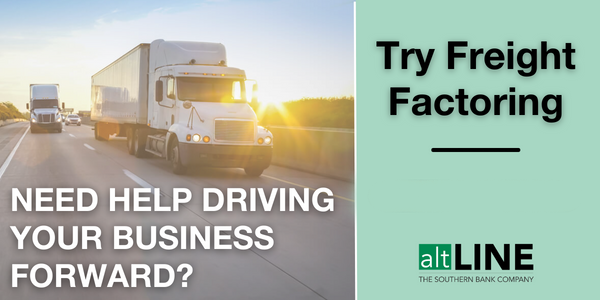How Will AI Impact the Trucking Industry?
Last Updated May 30, 2024
Artificial intelligence is becoming an increasingly popular global topic. From February 2022 to February 2024, Google searches for “AI” rose by a staggering 1000%, highlighting a common interest in just how impactful AI can become and what the implications might be.
The trucking industry is not exempt from those impacts. Self-driving cars have arrived and are here to stay. Therefore, you might think it’s only a matter of time before the arrival of self-driving trucks. If so, when might we see self-driving trucks on the road, and will truckers eventually be replaced by AI?
We’ll touch on these questions throughout this article, but it’s important to understand that there are other questions to ask and topics to consider beyond self-driving trucks when it comes to AI in trucking—especially considering AI is already impacting the trucking industry in a variety of ways.
Trucking business owners and anyone entering the industry should have an idea of the implications of AI in trucking. By knowing all of the AI-powered tools, how they’ve affected the trucking industry, and how they might be enhanced over time, you’ll likely be able to discover new ways to increase efficiency in your role.
What Is Artificial Intelligence?
Any machinery or software, such as a computer system, that is able to mimic human intelligence processes is considered artificial intelligence. Some of the most widely utilized examples of AI in society include the autocorrect feature on phones, navigation systems that can make real-time updates, voice-activated systems, and facial recognition.
While an AI-driven system like ChatGPT might make one assume these high-powered AI tools have suddenly advanced out of nowhere, it’s instead been a gradual progression and enhancement of these tools over time. This will continue to be the case moving forward.
AI Trucking Examples: How AI Is Currently Impacting the Trucking Industry
Artificial intelligence could have a massive impact on the trucking industry in the following years and decades, but it’s useful to understand that AI-powered tools have long been available in trucking. These tools have collectively made a major impact on how processes throughout the supply chain work. Below are a few examples.
AI Route Planning
In trucking, AI route planning occurs when a machine learning system relies on real-time data from GPS devices, traffic cameras, user-submitted traffic reports, and more to deduce the most efficient route for a truck or other delivery vehicle. Obviously, AI for route planning is utilized outside of the trucking realm as well. The vast majority of people use AI route optimization to find the quickest way to their destinations thanks to machines that can understand real-time data and output the most efficient solution based on said data.
Driver Assistance and Accident Prevention Systems
Automated driver assistance systems (ADAS) rely on both sensor technologies and AI processing algorithms to gauge the existing setting that a vehicle finds itself in. ADAS have become the norm in trucking, and the impact it’s made has been nothing short of lifesaving. ADAS systems have reduced vehicle accidents by 44%.
For instance, ADAS-powered systems detect blind spots and alert drivers to potentially unseen vehicles in their peripherals. This is hugely beneficial for truckers specifically, given that truck blind spots can extend up to 30 feet behind the trailer.
Other life-saving assistance features for truck drivers include automatic emergency braking and collision avoidance systems (CAS), which flash alerts to truckers before impending collisions. Even if a collision does unfortunately occur, the second or two of warning can save lives.
Driver Monitoring Systems
Driver monitoring systems (DMS) are specifically designed to detect distracted or tired drivers before an accident happens.
In trucking, one of the biggest challenges is preventing tired drivers from being behind the wheel. Truckers are in high demand, meaning existing truckers are forced to work longer hours, increasing the risk of accidents caused by drowsy truckers.
Driver monitoring systems often come in the form of sensors—such as wearable devices that detect signs of fatigue and alert drivers when it’s time to take a break. In some cases, these sensors can even track eye movements and other human cognitive states.
If a sensor detects fatigue, the application can take its intervention one step further thanks to AI. The system will suggest nearby rest stops or safe areas where a trucker can pull over, even suggesting nearby hotels or places to stay.
Predictive Maintenance
Predictive maintenance takes preventative maintenance one step further. While preventative maintenance involves simply performing routine maintenance check-ups to prevent future vehicle issues, predictive maintenance combines historical data with real-time monitoring to detect patterns that might suggest a piece of equipment might break or fail.
Given that equipment repairs and maintenance are some of the costliest expenses for owner-operators, this not only leads to safer vehicles, but also saves money.
Increased Data Consumption
Computer systems being able to consume large quantities of data isn’t an artificial intelligence process in itself, but trucking businesses have leveraged AI to take this data and turn it into actionable insights.
For instance, after inputting fuel consumption data, an AI-driven system can correspond said fuel data with vehicle types and even driver habits, revealing the efficiency of specific vehicles or truck drivers on their routes. This type of performance data can teach drivers how and where to improve; and on a larger scale, it can uncover significant cost-saving measures for trucking businesses.
Virtual Reality Systems for Driver Training
Virtual reality isn’t explicitly AI, but AI algorithms are required to create virtual reality environments.
In trucking, virtual reality is used for driver training. The combination of VR and AI allows drivers-in-training to experience simulations in the first person, preparing them for realistic, challenging situations behind the wheel. This can include configuring narrow turns, poor road conditions, severe weather conditions, or mountainous terrain.
Efficiency and Cost-Saving Measures
All of these above examples of AI in the trucking industry provide opportunities for trucking business owners to implement efficient and cost-saving measures in their business.
Even something as simple as route planning and real-time navigation is powered by AI. Imagine how difficult it would be to run a trucking business without a digitized map! Training methods for commercial truck drivers would look drastically different; VR (backed by AI algorithms) creates simulations that have become a significant chunk of the education required to become a driver. Predictive maintenance prevents trucking business owners from having to spend tens of thousands of dollars on broken equipment. Computers can analyze huge swaths of data and produce new data that can eventually prompt far more cost-efficient processes.
Owner-operators might be unaware of AI’s full presence and impact in the industry, but without it, their day-to-day life would look drastically different—and their pockets far emptier.
How Might AI Impact the Trucking Industry in the Future?
Now that you have an idea of how artificial intelligence is impacting the trucking industry right now, let’s look toward the future.
Increased Safety and Accident Prevention Measures
As technologies continue advancing, AI capabilities will become even more powerful.
Consider this: an emerging AI platform can scan drivers’ micro-muscle movements, which are reflective of brain activity that determines cognitive states, revealing how focused they are on the road. While this mechanism is only the result of a small startup company, it’s fair to assume that inventions like these will increasingly tap into mainstream business as years pass.
Additional Costs for Trucking Businesses
As AI technologies are introduced, owner-operators will need to keep up. Implementing these devices, training employees on how to use them, and managing them over time will become just another cost of starting a trucking business.
Ever-Changing Job Responsibilities and Day-to-Days of a Trucker
It’s no secret that experienced truck drivers have had a hard time keeping up with all of the emerging technologies. And for some, the constant technological oversight—such as electronic logging devices (ELDs) that monitor essentially every movement from within the cabin—has proven aggravating. These ELDs and AI-powered surveillance devices have made many truckers believe that they aren’t trusted by their employers, despite being in place to increase safety and efficiency.
Potential for Newfound Legal Implications
As automation progresses, the government will have to keep up by implementing rules and regulations for trucking businesses to adhere to.
New laws regulating AI are important. However, as it stands, the U.S. doesn’t have a federal law surrounding the use of AI. Artificial intelligence legislation is widely different on a state-by-state basis. Meanwhile, in 2023 the EU invoked the AI Act, which became the world’s first comprehensive AI law. In short, this act ensures any new use of AI does not pose a systemic risk.
The lack of wide-scale regulations involving AI could prove difficult for owner-operators to navigate. But if, or when, any government restrictions or laws on AI are passed, it will be critical for trucking business owners to gain an understanding of how it could affect their businesses, along with implementing this information into their new driver training.
Different Job Opportunities
Will trucking jobs be replaced by robots? This is a tricky question when it comes to AI.
There are plenty of unknowns pertaining to how AI will affect specific trucking roles in the future. But we do know one thing: jobs in trucking will look different because of artificial intelligence. We already have examples of this throughout the vast majority of professions. Many positions in the trucking industry require workers to input and analyze data produced by AI before using problem-solving skills to come up with takeaways from the data. As trucking industry employees gain experience with doing so, it can eventually qualify them for positions such as data analysts and logistics managers. In fact, data analysts across all industries are expected to increase by 25% through 2029.
Furthermore, drivers will be required to know how to interact with new AI inventions to keep up. There might even be blended roles—positions where tasks are commonly completed by AI-powered systems but need human oversight.
That brings us to the most intriguing dilemma surrounding AI in trucking: the emergence of autonomous semi trucks.
Self-Driving Trucks: Possible or Not?
So, will AI replace truck drivers? It’s a legitimate question. You see self-driving personal vehicles on the road, so it’s inevitable that self-driving trucks are in the works. But when?
We could be only a few years away. In early 2024, one self-driving trucking firm announced they had finalized the design of a self-driving trucking system that could be ready for use by 2027.
However, reports show that we won’t see self-driving trucks on the road en masse for several years, if not decades. A more realistic short-term scenario is hybrid trucks, where autonomous trucks are monitored through the presence of a human. Sure, the job responsibilities might look different, but human oversight would still be required.
While yes, there is a future where AI could replace truck drivers, these autonomous vehicles will still require human supervision and control as they are first introduced. We’re not close to a world where driverless semi-trucks can be trusted on the road.
Implications of AI in Trucking: Weighing the Pros and the Cons
There are undoubtedly both benefits and potential pitfalls of AI’s integration in the trucking industry.
| Pros of AI in Trucking | Cons of AI in Trucking |
| AI-powered safety features, such as driver assistance and accident prevention systems, should be a net-positive for overall driver safety | Implementing AI technologies can be costly for owner-operators |
| Virtual reality systems with AI-powered features very beneficial for new driver training | Potential legal ramifications of misuse or failed oversight of AI-driven systems |
| AI route planning has made, and will continue to make for loads to be delivered quicker, boasting overall efficiency | Potential for fully autonomous semi-trucks to eliminate truck driving jobs in the future |
| Predictive maintenance acts as a significant cost-saving measure | Constantly changing job responsibilities and skills required can frustrate drivers, especially experienced drivers who did not need to learn how to use these technologies when entering the field |
Pros of AI in Trucking
The benefits of AI in trucking are significant. We’ve already seen proven positive results of AI’s integration into the trucking industry via driver assistance and specific accident prevention features reducing the number of trucking-related accidents.
Virtual reality wouldn’t be possible without AI, and it’s been a huge help for helping new drivers learn how to navigate tricky situations such as driving in mountainous terrain, driving in tough weather conditions, and making narrow turns.
AI route planning, which is the result of GPS systems using real-time data to inform drivers of the quickest routes, ensures optimal efficiency for trucking businesses when their drivers are on the road. This is just one example of AI in trucking acting as a cost-saving measure. Predictive maintenance features also prevent major, unexpected truck system failures, alerting drivers of dormant issues before the problem turns even more costly and a truck breaks down while on the road.
Finally, while self-driving trucks do pose a threat to the driver workforce (a significant con in itself), the possibility of fully autonomous semi-trucks does offer a glimpse into a future where trucking businesses don’t have to devote as much of their budget to hiring drivers. There’s also a national truck driver shortage, so these automated trucks could be a positive from the trucking business owner point of view. And from drivers’ perspective, even driverless semis would still require human supervision and intervention, possibly creating an entirely different sector of jobs.
Cons of AI in Trucking
The most newsworthy and potentially impactful con of AI in trucking is the possibility of the possibility of truck drivers being replaced by AI. In the U.S. alone, this puts the 3.5 million people who make a living driving trucks at odds. However, since we’re by all accounts several years away from this posing a real threat to the workforce, there isn’t a whole lot of data surrounding what this might exactly mean for the workforce.
On a smaller scale, the downsides of AIs integration in the trucking industry include the possibility of overreliance, misuse, or failed oversight of AI-powered safety features. There are potential legal ramifications for trucking companies who don’t do their due diligence. And to implement all of these features can prove costly for new or small owner-operators who are operating on a tight budget.
As for truck drivers, job responsibilities and required skill sets are also ever changing thanks to the introduction of advanced technology. This can be difficult for more experienced drivers who never had to worry about knowing how AI-powered systems and devices operate when they first began their careers.
In-Summary: How Will AI Impact Trucking?
The question, “how will AI impact trucking,” is one that we already know much of the answer to because its impact has already been felt. Many drivers may not realize just how much of their experience when operating a vehicle has already been altered by AI. Predictive maintenance, accident prevention measures such as lane change assist, and AI route planning all play massive roles for standard motor vehicle drivers and truck drivers alike.
That said, there’s a long way to go for AI in trucking. Semi-trucks are getting more autonomous by the year, and a future of completely self-driving trucks is very much something the entire industry needs to prepare for. However, we’re yet to fully understand what the ramifications of the future might be.
AI in Trucking FAQs
What are some examples of automation in trucking?
While the future of trucking is going to look different than it does today thanks to AI and other technological advances, there are already plenty of examples of how automation in trucking has affected the industry for better or for worse. For instance, automation is at the forefront of accident prevention and safety measures that have been implemented in recent years, such as lane change assistance, driver fatigue signals, and predictive maintenance. However, as truck driving becomes more automated, there could become less of a demand for drivers. Plus, there are costs associated with keeping up with all of these automation tools, such as the need for additional driver training
What is the future trucking industry outlook?
The trucking industry was impacted by inflation and a national driver shortage in 2023, but there’s reason for optimism when it comes to the future, though it will continue taking some time as the effects of inflation are still being felt. Analysts believe the market for carriers will likely have improved by the latter half of 2025.
When will trucks be self-driving?
Self-driving trucks have already been successfully test-driven, meaning we’re not far off from seeing fully autonomous trucks on the road. While the majority of trucks are set to remain manually operated for the next few years, there is reason to believe self-driving trucks will be operating on America’s interstates by 2027 or 2028.
Aurora Innovation, a self-driving vehicle company, is at the forefront of these autonomous semi-trucks. They expect thousands of their and their competitors’ fully autonomous semi-trucks to be operating within three to four years.
Michael McCareins is the Content Marketing Associate at altLINE, where he is dedicated to creating and managing optimal content for readers. Following a brief career in media relations, Michael has discovered a passion for content marketing through developing unique, informative content to help audiences better understand ideas and topics such as invoice factoring and A/R financing.




